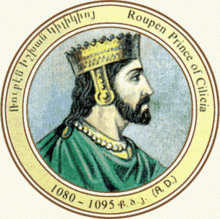Ruben I, Prince of Armenia
Friday, May 14, 2021
Ruben I, (Ռուբեն Ա), also Roupen I or Rupen I, (1025/1035 – Kormogolo, 1095) was the first lord of Armenian Cilicia or “Lord of the Mountains” (1080/1081/1082 – 1095). He declared the independence of Cilicia from the Byzantine Empire, thus formally founding the beginning of Armenian rule there. The Roupenian dynasty ruled Cilician Armenia until 1219.
he Armenian voluntary immigrations into the Byzantine Empire began as early as the 6th century; from the reign of Emperor Maurice (582–602) onwards they were solidly incorporated into the military fabric of the Byzantine army. The Armenian migration to the south-west, began when the Seldjuk invasions made life in the Araxes valley and by Lake Van no longer secure. By the mid 10th century, large numbers of Armenian settlements were well underway in Cilicia.
Greater Armenia was ruled by the Bagratids in relative peace and prosperity from the 9th century until 1045 when their capital city of Ani fell. In 1045, King Gagik II was invited to Constantinople; upon arrival there, he was taken captive and under duress was forced to abdicate his throne and relinquish all his right in Armenia in exchange for lands in Cappadocia. Thus Ani was relinquished to Emperor Constantine IX Monomachos who began the resettlement of large numbers of Armenians in Byzantine Cilicia. Gagik was killed by Byzantine orders in 1079, after his own peculiarly atrocious murder of the Archbishop of Caesarea (today Kayseri in Turkey).
The Seldjuks also played a significant role in the Armenian immigration into Cilicia. In 1071, Sultan Alp Arslan put an end to Byzantine dominance in the east with his most convincing victory at the battle on the plains of Manzikert, where Emperor Romanos IV Diogenes was taken captive.
The consensus appears to be that the Roupenians were the descendant of the Bagratids, and Roupen was a relative of the last Bagratid king, Gagik II. The Armenian chronicler Kirakos Gandzaketsi speaks of the Roupenians as ‘the sons and descendants of Gagik Artsruni’. Another Armenian chronicler, Vahram, a personal secretary of King Levon II refers to Roupen as ‘a famous chief of the blood royal, Rouben by name’. On the other hand, the claims in these primary sources of a family relationship with the kings of the Bagratid dynasty are implausible.It is felt that, if such a connection had existed, the sources would have given specific details, given the otherwise reasonably complete genealogies which can be reconstructed from the information which they contain.
Roupen, according to the general consensus of the Armenian chroniclers, was a commander in the king’s armies. After the surrender of Ani to Constantine IX, a number of King Gagik II’s rinses and loyal adherents, among them Roupen faithfully followed the king’s court into exile and resettled in the district of Caesarea in Cappadocia. However upon the murder of Gagik II, Roupen gathered his family and fled to the Taurus Mountains and took refuge in the fortress of Kopitar (Kosidar) situated north of Sis (today Kozan in Turkey). The territory of the Armenians in the Taurus was hard of access and easy to defend.





